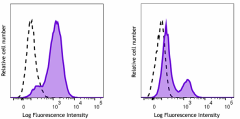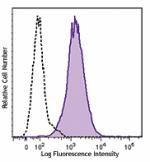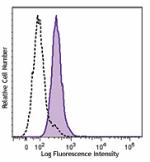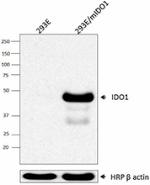- Clone
- 2E2/IDO1 (See other available formats)
- Regulatory Status
- RUO
- Other Names
- Indolamine 2,3-dioxygenase, Indole 2,3-dioxygenase, Indoleamine-pyrrole 2,3-dioxygenase
- Isotype
- Mouse IgG1, κ
- Ave. Rating
- Submit a Review
- Product Citations
- publications

-

Mouse IDO1 transfected 293 cells were treated overnight (left) or untreated (right) with doxycycline, then fixed & permeabilized using Cyto-Fast™ Fix/Perm Buffer Set (Cat. No. 426803), and intracellularly stained with anti-IDO1 (clone 2E2/IDO1) PE (filled histogram) or mouse IgG1, κ PE isotype control (open histogram).
| Cat # | Size | Price | Quantity Check Availability | Save | ||
|---|---|---|---|---|---|---|
| 654005 | 25 µg | 176 CHF | ||||
| 654006 | 100 µg | 393 CHF | ||||
IDO1 is also known as Indolamine 2,3-dioxygenase, Indole 2,3-dioxygenase, and Indoleamine-pyrrole 2,3-dioxygenase. IDO is a ubiquitously expressed cytoplasmic protein with a predicted molecular weight of approximately 45 kD. Indoleamine 2,3-dioxygenase (IDO) is one the best known IFN-γ inducible genes. The product of IDO gene catalyzes the degradation of the essential amino acid L-tryptophan to N-formylkynurenine. IDO has been implicated to protect against intracellular and extracellular pathogens. It also has been shown to maintain the special immune suppressive status of immune-privileged sites such as the brain, eyes, kidney, and placenta.
Product DetailsProduct Details
- Verified Reactivity
- Mouse
- Antibody Type
- Monoclonal
- Host Species
- Mouse
- Immunogen
- Recombinant mouse IDO1.
- Formulation
- Phosphate-buffered solution, pH 7.2, containing 0.09% sodium azide
- Preparation
- The antibody was purified by affinity chromatography and conjugated with PE under optimal conditions.
- Concentration
- 0.2 mg/mL
- Storage & Handling
- The antibody solution should be stored undiluted between 2°C and 8°C, and protected from prolonged exposure to light. Do not freeze.
- Application
-
ICFC - Quality tested
- Recommended Usage
-
Each lot of this antibody is quality control tested by intracellular immunofluorescent staining with flow cytometric analysis. For flow cytometric staining, the suggested use of this reagent is ≤ 1.0 µg per million cells in 100 µL volume. It is recommended that the reagent be titrated for optimal performance for each application.
- Application Notes
-
Clone 2E2/IDO1 reacts with mouse IDO1. It does not appear to react with mouse IDO2.
Clone 2E2/IDO1 is the same clone as anti-IDO1 clone 2E2.6. - RRID
-
AB_3097459 (BioLegend Cat. No. 654005)
AB_3097459 (BioLegend Cat. No. 654006)
Antigen Details
- Structure
- 403 amino acids with a predicted molecular weight of 45 kD.
- Distribution
-
Cytoplasm
- Function
- Indoleamine 2,3-dioxygenase (IDO) is an IFN-γ inducible gene. It catalyzes the degradation of the essential amino acid L-tryptophan to N-formylkynurenine. IDO has been implicated to protect against intracellular and extracellular pathogens.
- Interaction
- This enzyme acts on multiple tryptophan substrates including D-tryptophan, L-tryptophan, 5-hydroxy-tryptophan, tryptamine, and serotonin.
- Biology Area
- Cell Biology, Immunology
- Antigen References
-
1. Habara-Ohkubo A, et al. 1991. Gene 105:221.
2. Munn DH, et al. 2002. Science 297:1867.
3. Frumento G, et al. 2002. J. Exp. Med. 196:459.
4. Muller AJ, et al. 2005. Nature Med. 11:312.
5. Lob S, et al. 2009. Nature Rev. Cancer 9:445. - Gene ID
- 15930 View all products for this Gene ID
- UniProt
- View information about IDO1 on UniProt.org
Related Pages & Pathways
Pages
Related FAQs
- What type of PE do you use in your conjugates?
- We use R-PE in our conjugates.
Other Formats
View All IDO1 Reagents Request Custom Conjugation| Description | Clone | Applications |
|---|---|---|
| Purified anti-IDO1 | 2E2/IDO1 | WB |
| Alexa Fluor® 647 anti-IDO1 | 2E2/IDO1 | ICFC |
| PE anti-IDO1 | 2E2/IDO1 | ICFC |
| TotalSeq™- B0017 anti-IDO1 | 2E2/IDO1 | ICPG |
Compare Data Across All Formats
This data display is provided for general comparisons between formats.
Your actual data may vary due to variations in samples, target cells, instruments and their settings, staining conditions, and other factors.
If you need assistance with selecting the best format contact our expert technical support team.
-
Purified anti-IDO1
Total cell lysates (15 µg protein) from 293E untransfected o... -
Alexa Fluor® 647 anti-IDO1

Mouse IDO1 transfected 293 cells were treated overnight (top... 
-
PE anti-IDO1

Mouse IDO1 transfected 293 cells were treated overnight (lef... -
TotalSeq™- B0017 anti-IDO1
 Login / Register
Login / Register 













Follow Us